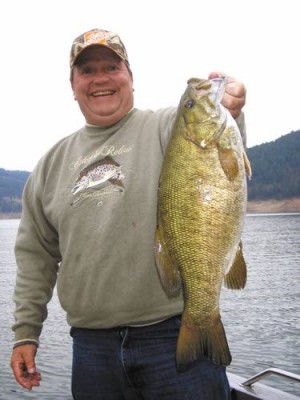forum
library
tutorial
contact

WDFW Removes Bag Limits for Bass, Walleye, Catfish
on Columbia River, Tributaries to Protect Salmon
by Staff
Columbia Basin Bulletin, March 4, 2016
|
the film forum library tutorial contact |

|
WDFW Removes Bag Limits for Bass, Walleye, Catfish
by Staff
|
 Anglers can now fish for bass, walleye and channel catfish without daily catch or size limits from the mouth of the Columbia River 545 miles upstream to Chief Joseph Dam.
Anglers can now fish for bass, walleye and channel catfish without daily catch or size limits from the mouth of the Columbia River 545 miles upstream to Chief Joseph Dam.
An emergency rule approved by the Washington Department of Fish and Wildlife removes the remaining limits for those species on the Columbia River downstream from the Washington/Oregon state line, 17 miles above McNary Dam.
It also lifts fishing limits for those species on nearly two-dozen tributaries flowing into that section of the Columbia River.
The new rule is consistent with fishing regulations in effect since 2013 on the upper Columbia River and with those approved last year for boundary waters shared by Washington and Oregon further downstream, said Bruce Bolding, WDFW warmwater fish manager.
"The immediate purpose of this emergency rule is to bring the fishing regulations into alignment on both sides of the big river," Bolding said. "Oregon's rule deregulating these fisheries has been in place since Jan. 1, but Washington's new permanent regulations don't take effect until July 1. This emergency measure bridges the gap so that both states have concurrent regulations."
Tributaries affected -- all or in part -- by that action include Camas Slough, Chinook River, Deep River, Grays River, Skamokawa Creek, Elochoman River, Mill Creek (Cowlitz Co.), Abernathy Creek, Germany Creek, Coal Creek, Falls Creek (Cowlitz Co.), Kalama River, Cowlitz River, Lewis River, Salmon Creek (Clark Co.), Washougal River, Hamilton Creek, Rock Creek (Skamania Co.), Wind River, Drano Lake, White Salmon River, Klickitat River, and Rock Creek (Klickitat Co.).
Fishing seasons, boundaries and other rules for those rivers and streams are described on WDFW's website.
The main goal of deregulating the fisheries for bass, walleye and channel catfish is to increase the harvest of those non-native species, Bolding said.
"All three species are abundant, and prey on juvenile salmon and steelhead that are listed for protection under the federal Endangered Species Act," he said. "These new rules are designed to help address that issue."
learn more on topics covered in the film
see the video
read the script
learn the songs
discussion forum
